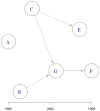Concordance of randomized and nonrandomized studies was unrelated to translational patterns of two nutrient-disease associations
- PMID: 22047889
- PMCID: PMC3809069
- DOI: 10.1016/j.jclinepi.2011.07.006
Concordance of randomized and nonrandomized studies was unrelated to translational patterns of two nutrient-disease associations
Abstract
Objective: There are several examples in nutrition of discordance between the results of observational studies and randomized controlled trials (RCTs). We hypothesized that this discordance is attributable to differences in the translational paths of nutrient-disease associations. Translational paths can be assessed using citation analysis.
Study design and setting: We compared the characteristics of citation networks using examples, where RCTs and observational studies agreed (long-chain n-3 polyunsaturated fatty acids [n-3 PUFA]) or disagreed (vitamin E). We performed systematic reviews in each example, constructed citation networks, and compared them with respect to the number of articles and citation relationships between them, as well as the distribution of articles' hub and authority scores.
Results: For n-3 PUFA, meta-analyses of 14 RCTs and 10 observational studies both suggested that higher intake was associated with lower cardiovascular mortality. For vitamin E, the meta-analysis of 14 RCTs excluded a clinically significant effect, whereas 14 observational studies reported a significant inverse association. The respective citation networks consisted of 392 (n-3 PUFA) and 351 (vitamin E) articles. No differences between the characteristics of the two networks were identified. There was no evidence that the observational studies predated RCTs in the translational process in either example.
Conclusion: In the two examples, citation network characteristics do not predict concordance in the results of observational studies and RCTs.
Copyright © 2012 Elsevier Inc. All rights reserved.
Conflict of interest statement
Figures






References
-
- Esmaillzadeh A, Kimiagar M, Mehrabi Y, Azadbakht L, Hu FB, Willett WC. Fruit and vegetable intakes, C-reactive protein, and the metabolic syndrome. Am J Clin Nutr. 2006;84:1489–97. - PubMed
-
- Koushik A, Hunter DJ, Spiegelman D, Anderson KE, Buring JE, Freudenheim JL, et al. Intake of the major carotenoids and the risk of epithelial ovarian cancer in a pooled analysis of 10 cohort studies. Int J Cancer. 2006;119:2148–54. - PubMed
-
- Lee JE, Giovannucci E, Smith-Warner SA, Spiegelman D, Willett WC, Curhan GC. Intakes of fruits, vegetables, vitamins A, C, and E, and carotenoids and risk of renal cell cancer. Cancer Epidemiol Biomarkers Prev. 2006;15:2445–52. - PubMed
-
- Lin J, Zhang SM, Cook NR, Rexrode KM, Liu S, Manson JE, et al. Dietary intakes of fruit, vegetables, and fiber, and risk of colorectal cancer in a prospective cohort of women (United States) Cancer Causes Control. 2005;16:225–33. - PubMed
-
- Shai I, Jiang R, Manson JE, Stampfer MJ, Willett WC, Colditz GA, et al. Ethnicity, obesity, and risk of type 2 diabetes in women: a 20-year follow-up study. Diabetes Care. 2006;29:1585–90. - PubMed
Publication types
MeSH terms
Substances
Grants and funding
LinkOut - more resources
Full Text Sources

